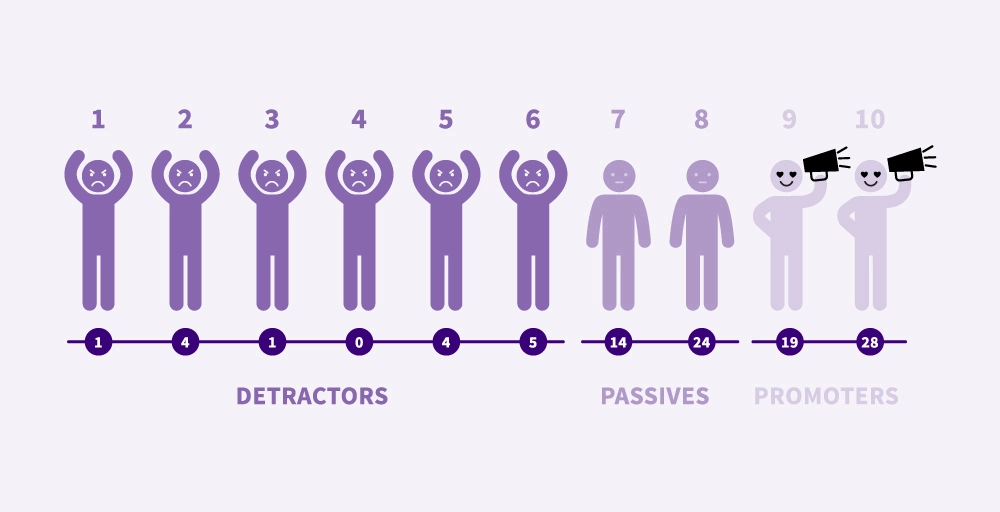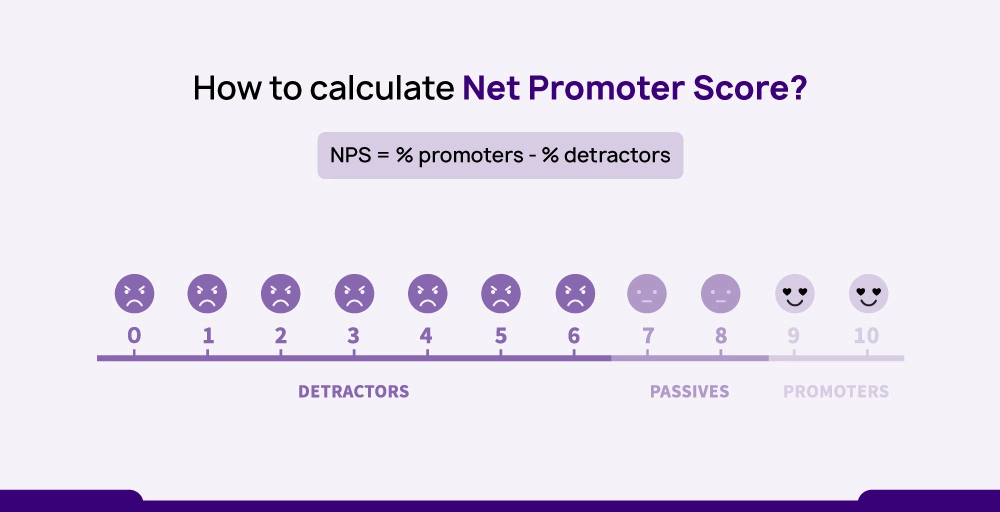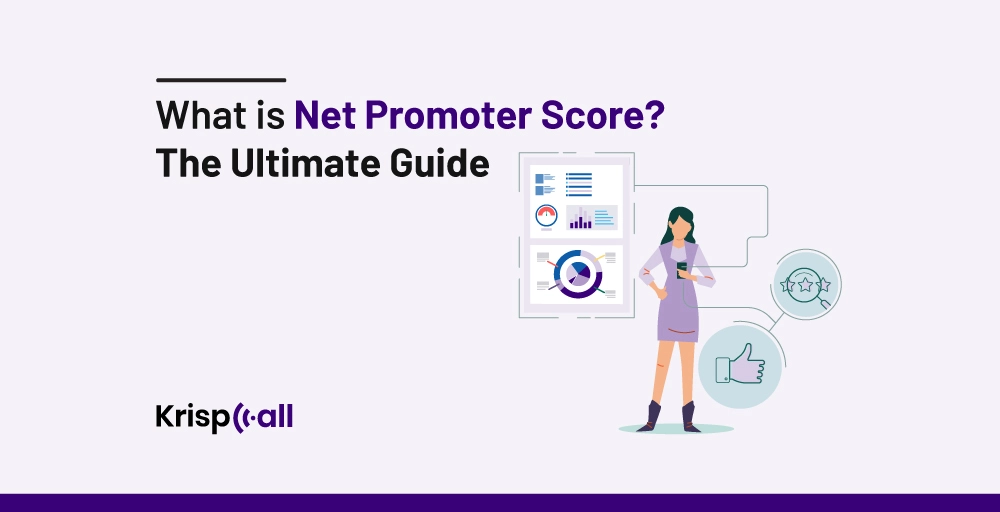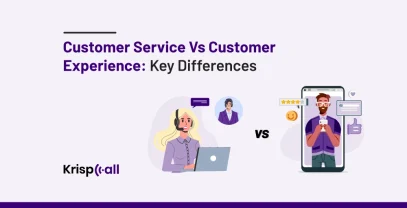Do you want to know if your customers want to recommend your company to their friends or check if your customers are well satisfied? 😀
Maybe yes✅. With a Net Promoter Score, you know the customers’ perceptions about your company.
But how and what is the Net Promoter Score? 🤔
Net Promoter Score is an indicator that measures customer loyalty to your brand by analyzing the customer’s likelihood of recommending your business to their friends and colleagues. This is done by questioning the customers and asking for ratings on a scale of 0 to 10 through a survey.
Read this article till the end to know more about Net Promoter Score, including why it is essential and how to calculate and use the NPS score to improve your business.
Without delay⌛, let’s dive 🌊 into the ultimate guide of Net Promote Score.
🔑KEY HIGHLIGHTS
- Net Promoter Score (NPS) is a metric used to measure customer loyalty and how likely customers are to recommend a company’s product or service to others.
- NPS helps to monitor the customer experience through the website or email surveys to enhance the business’s overall growth.
- The NPS calculation formula is ( NPS = % of promoters – % of detractors).
- The net promoter score measures whether customers are satisfied with the products and services or need improvements.
What is Net Promoter Score (NPS)?
Net Promoter Score (NPS) is a metric used to measure how likely customers are to recommend a company’s product or service to their friends and colleagues. Millions of businesses use it to measure customer perception of their businesses. In 2003, Fred Reichhled, a partner of Bain & Company, developed the first idea of NPS.

All organizations, including call centers, department stores, healthcare providers, and internet service providers, are likely to use Net Promoter Scores (NPS).
A company conducts an NPS survey asking customers one question: “How likely are you to recommend us to your friends or colleagues on a scale of 0 to 10,?” the business’s net promoter score is listed between -100 and + 100, and the higher the score is, the more customers are expected to be satisfied.
Why is Net Promoter Score important?
It is always important to analyze how customers feel about a company’s product and service, which is why the net promoter score is important. Besides that, companies can get numerous benefits from NPS.
Net Promoter Score can benefit businesses in the following ways:
- Easy implementation: The net promoter system requires no trained expertise to place surveys. You can send the NPS surveys through email or include surveys on the website as a pop-up after the customer makes a transaction, and the formula can be calculated easily using spreadsheets.
- Comparison for competing: NPS is used globally as a standard metric for measuring customer experience. This lets you compare your scores with competitors in your industry, making you work hard on customer experience.
- Monitoring annual or quarter performance: Relational NPS surveys can help you monitor your business’s overall performance and impact on customer satisfaction quarterly and annually. This also gives a chance to improve the negative customer impression in the coming year.
- Enhancing growth: Once companies start asking and analyzing NPS questions as an important metric, it eventually helps them improve their customer service systems. Good NPS scores mean that companies can grow profit through customer referrals.
How to calculate Net Promoter Score?
After creating a survey and asking, “ How often would they like to recommend the businesses to their friends or colleagues?”. Customers rate it on a scale of 0 to 10. After this, Customers are categorized into 3 categories depending on the ratings they provide: Promoters, Passives, and Detractors.
Detractors ( 0 – 6 ): Customers who rate between 0 to 6 are counted as detractors who are not satisfied with the product or service of the company.
Passives ( 7 – 8): Passives are expected to have a good experience with the company’s service but don’t feel it is promoteworthy.
Promoter ( 9 or 10): Customers rating between 9 to 10 are categorized as promoters, and they are usually likely to recommend the company’s product or service to others.

After all the reviews have been collected, you need to subtract the % of detractors from the % of promoters ( % Promoters – % Detractors ) to calculate the Net Promoter Score.
Also, the alternative formula for calculating NPS is
(number of promoters – number of detractors ) / ( Number of responses ) * 100.
For example: if there were 100 responses, 60 promoters, and 30 detractors, then the Net Promoter Score ( NPS) formula would be (60-30)/(100) *100, which is equal to a 30 NPS score, which is considered favorable.
What is a good Net Promoter Score?
Good Net Promoter Score can differ according to the industries and their benchmarks. According to the creator of NPS, Bain & Company, the following are the customer experiences:
- A score above 0 is considered good.
- Above 20 is considered a positive score.
- Above 50 is considered outstanding and
- A score above 80 is regarded as a world-class score.
Like every other industry, you must aim for a world-class NPS of 80+. This ensures that customers are well-satisfied and feel no burden to promoting your company’s services or products to their friends and colleagues. According to CustomerGauge, in 2023, Princeton Mortgage scored 98 in NPS, and Tesla scored 97, examples of good NPS.
What is a bad Net Promoter score?
Like a good promoter score, a bad Net Promoter Score can also differ according to the company’s benchmarks. But if the score is below 0, it indicates that the business has several detractors higher than the promoters.
If a company’s NPS score was -5 last year, it seems to have had a bad customer experience impact. Still, if we compare it with the competitor company’s score of -10, the first company’s score eventually starts looking not that bad.
Whenever the NPS bar gets lower, it is a sign that the company should seriously work on improving the customer experience.
What can you measure using the Net Promoter Score?
You can measure various factors like customer retention, loyalty, customer churn, customer experience, etc, using the Net Promoter Score. These factors help you analyze customers’ perceptions of your services or products.
- Measuring customer retention and loyalty: You can get insight into customer loyalty and customer retention through Net Promoter Scores. The higher the NPS score gets, the higher the customer loyalty and retention rates are expected to grow, and vice versa.
- Measuring customer churn: The ratio of unsatisfied customers can be measured through NPS, which gives businesses an early warning about unsatisfied customers and can help estimate the likelihood of customer churn.
- Monitoring the room for improvements: A proper customer experience survey and the scores can help you measure your score and determine whether customers are happy with it or need to improve their service or products. This enables companies to evolve constantly.
- Analyzing customer perception and experience: Customer perception and customer experience play an important role in overall business growth. With Net Promoter Score, businesses can learn how their customers feel or how they pursue their products and services and improve in the needed area.
Transactional Vs. Relational NPS: What are the differences?
While both Transactional and Relational NPS surveys measure customer loyalty and determine whether customers want to recommend a company’s products and services, they differ in many ways.
Differences between transactional and relational NPS are listed below in a table:
| Transactional NPS | Relational NPS |
| The question for the survey is sent just after the customer interacts with the company | The survey is done on a quarterly or annual basis. |
| Measures customer satisfaction on a granular level. | Measures the customer relationship year-on-year. |
| Understand the overall customer experience. | Understand solely about an individual experience. |
| Instant surveys can annoy customers. | Much more favorable way for doing surveys. |
How can you use your Net Promoter Score (NPS) score to improve the business?
The net promoter score is often used to monitor and analyze the customer experience, which eventually helps companies identify areas for improvement.
NPS score can be used in many ways to improve the business.
- For measuring customer loyalty: The NPS score can give you insights into the ratio of loyal and detractor customers within your business. When the NPS score gets low, it is a sign that you need to work on some factors to maintain customer loyalty and improve business.
- To reduce the chances of customer churn: A proper analysis of the customer reviews in surveys helps indicate if there are possible customer churns. Addressing these factors and working on them reduces the chances of them occurring.
- To understand customer perception: The NPS score is a chance to know how customers feel about your services and products and their preferences. The higher the score, the more likely customers are to have a good perception and impression of your services. This insight will eventually help to grow the customer service experience for business growth.
- For finding room for improvement: If the NPS score is low, use it to motivate further growth. Even if the scores are good, some users may still have rated low, and by knowing the reason, you can identify the room for improvement and solve those problems as soon as possible.
- For monitoring the business performance: The net promoter score can decide whether the business performance seems good to its customers. A higher score means the business performance is increasing, and a lower score refers to the need for improvements. Both cases can be used to have an analysis to create business strategies for improving overall performance.
How to create an NPS survey?
There are two main methods to run an NPS survey: one is to add pop-up options after the purchase is completed, which is more like a Website survey. Another is to let customers use your products and service for some periods and ask them to complete a survey through the mail, which is an Email survey.
One of the primary NPS surveys includes the question, “ How likely are you to recommend us to your friends and colleagues ? on a scale between 0 and 10. “. Multiple questions can also be added to create a smooth flow of customer questions and obtain more customer information.
Follow these steps for creating a proper NPS survey:
Start with demographic questions if needed
Asking demographic questions like gender, age, and income is common when starting an NPS survey. Information from this response can be used to segment customers, which will be helpful for future use. If it’s not needed, you should skip this process and get information about customers through the customer database. The lower the questions are, the better the survey.
The main Net Promoter Score question
The primary and deciding question for measuring your score. It goes like this,“ How likely are you to recommend us to your friends and colleagues? on a scale between 0 and 10. “With the response to this question, the requirement is fulfilled for the NPS survey, whereas you can still ask some other questions that help you know the reason behind the score.
What is the reason for your score, and how can we improve it?
This is an open-text question where you question the customers for their reasons behind the specific score in the previous question and what suggestions the customer would like to give to improve the overall customer experience. Answers to these questions help in improving the specific sectors you lack. Remember, these questions are not mandatory and can be skipped if not needed.
Ask permission for follow-ups
It is always wise to ask customers for follow-up permission. Some customers won’t want to discuss their issues, which is fine. You must follow up with customers who gave permission and start interacting with them. For this, the required email or contact information can be obtained through the customer database, or you can simply ask them to fill out their contact information. However, asking them until and unless you have their data in your system is not recommended.
Wrapping Up!
Net Promoter Score helps identify if the business is doing well with its customers and improving in customer service sectors. Its easy use and factor for enhancing business growth make this score more valuable. Businesses should look for ways to achieve good Net Promoter Scores to compete with their competitors. Monitoring the business performance, whether quarterly, yearly, or just after the purchase, is crucial to better understand customer perception.
Everyone can create NPS surveys via email. Starting with demographic questions and ending by asking permission to follow up in needed terms can be an engaging outline for the survey. To ease the decision, use a transactional NPS survey method if your product constantly changes; otherwise, a relational NPS survey is recommended for preview for a few months or years.
FAQs
What is the NPS rating?
A Net Promoter Score (NPS) rating is a customer loyalty metric that determines how likely it is that customers will refer a company’s product or services to others.
What should you ask when you run an NPS survey?
The primary question to ask when running the NPS survey is, “ How likely the customers are to recommend (organization name) to their friends and colleagues? On a scale of 0 to 10.
When should you run the NPS survey?
The best time to run an NPS survey is after a specific and enough interaction with your company or brand. Let customers experience enough about the business offering to know if they want it to be recommended to others.
How often should we measure NPS?
It is recommended that you measure NPS quarterly to understand your company’s customer experience. However, this depends on factors like how frequently you change your products or what industries you belong to.
What should we do if our NPS is low?
If you realize your NPS is low, you can follow up with customers through the interaction history to understand their pain points and what caused a bad experience. This will help you know what customers want and stop customer churn.
Can NPS predict business growth?
Yes, NPS can be an indicator for predicting business growth. Though it is not precise, customer reviews can help businesses analyze possible business growth.





